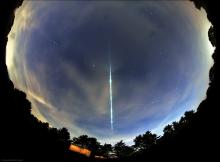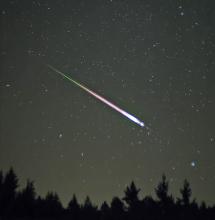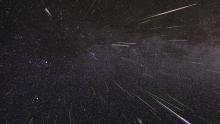Listen to today's episode of StarDate on the web the same day it airs in high-quality streaming audio without any extra ads or announcements. Choose a $8 one-month pass, or listen every day for a year for just $30.
You are here
Morning Treats
The early morning sky offers up a couple of beautiful sights tomorrow. One is a meteor shower, although you need to be far from city lights to see it. The other is visible from any place with clear skies: a pairing of the Moon and the planet Jupiter.
The Eta Aquariid meteor shower should be at its best over the next couple of nights. It fires up as Earth flies through the orbital path of Comet Halley. Dust grains from the comet plunge into the atmosphere at speeds of up to 150,000 miles per hour. They quickly vaporize, forming the glowing slashes of light known as meteors. Almost all of them are too faint to see from the city, though.
Unfortunately for those of us in the U.S., the shower is best viewed from the southern hemisphere. That’s because its meteors appear to “rain” into the sky from the constellation Aquarius. From North America, it doesn’t rise until the wee hours of the morning. And it scoots quite low across the southern horizon, so we don’t get the full glory of the shower. Instead, we might see a dozen or so meteors per hour at most.
Coincidentally, the planet Jupiter is at the edge of Aquarius right now. It’s low in the southeast at first light, and looks like a brilliant star. Tomorrow, it’ll stand to the upper right of the Moon at first light. The moonlight will wash out the remaining meteors. But the Moon will rise later on Thursday, providing a little extra time to watch the end of the shower.
Script by Damond Benningfield





